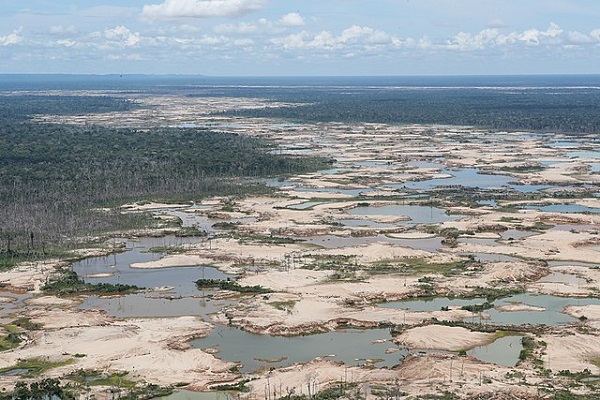On June 8th, the United States embassy in Brazil posted an alert on its twitter: “U.S. citizens should avoid non-essential travel to Manaus until security conditions improve, especially travel via public transportation. Organized criminal groups in the city have violently attacked police stations, buses, and other public areas.” The crisis currently unfolding in the capital of the Amazonas State is not related to criminal violence only. Other serious challenges have recently taken a toll on human safety in the entire western Brazilian region (including the States of Roraima, Amazonas and Rondônia). Some of these challenges are recurrent, some of them are linked to the pandemic and others are more systemic.
What are the main risk factors that threaten stability in Western Brazil in the short and long terms? In this Focus, we will see that the population in the region is suffering from the consequences of historical floods, the COVID-19 pandemic, violence due to organized crime, conflict between indigenous populations and gold miners, and the struggle against illegal deforestation and drug smugglers.
THE FlOOD
Since May 2021, the state of Amazonas has been affected by the largest flood in its 119-year history. The Rio Negro reached its highest level since 1902, when historical records began, reaching 30 meters at the Port of Manaus. Workers built barricades and placed sandbags to hold back the floodwaters in the city’s Historic District, trying to save buildings and monuments from damage. The flood is causing ravages across the State. According to data from the Civil Defense, more than 455.000 people have been affected and 20.000 people had to leave their homes. Of the 62 cities in Amazonas State, 48 were in a state of emergency.
COVID-19 AND FIRES
Amid a pandemic and the harbinger of a new rise in COVID-19 contaminations —months after a crisis led to the death of patients with the disease due to lack of oxygen— the death rate from coronavirus among the indigenous population in the Amazon is almost 250% higher than in the general population, according to a study by the Amazon Environmental Research Institute.
In addition, fires in the Amazon rainforest have increased for the last years. Worsening forest fires are very negative for the Earth’s ecosystem due to climate change, according to a report by the Global Climate Alliance, a consortium of health organizations around the world. In the long term, it may also lead to greater vulnerability to the more serious effects of COVID-19, according to researchers. “A drop in air quality in the northern region during a pandemic of a respiratory disease is an explosive combination,” said Mario Vianna, president of the Amazonas State Physicians Union.
DEFORESTATION, ILLEGAL GOLD MINING AND MALNUTRITION
On June 15th, the Federal Police requested that the investigation into the largest seizure of illegal timber in the Amazon (226000 cubic meters of wood, with an estimated value of more than 129 million BRL) concentrated at the STF (Federal Supreme Court), to be carried out together with the investigation involving the Minister of the Environment, Ricardo Salles.
In the Yanomami Indigenous Land, the largest reserve in the country located in the state of Roraima on the border with Venezuela, the indigenous population suffer from recurring cases of malnourished children and conflicts with illegal miners. The scourge of malnutrition is directly linked to the illegal gold mining. The extraction of the ore with mercury contaminates the rivers, killing animals and impacting the availability of food. The miners are also responsible for constant armed attacks on the communities in the dispute for territory. The widespread presence of illegal miners (the estimated number is 20.000, compared to the little more than 28.000 locals who live in the reserve) has yet another harmful effect: the transmission of diseases, including COVID-19.
LAND INVASIONS, ROBBERIES AND DRUG TRAFFICKING
Even with continuous police operations in the state, land invasions in the southern cone of the state of Rondônia, on the border with Bolivia, are a cause for concern. Both the borders of national parks and indigenous lands are the target of loggers, ranchers, land grabbers and miners. The conflict for land, even in times of pandemic, has increased and areas have been allotted even over the internet, encouraging the occupation of public lands. With the rural areas facing the problem of land occupation and piracy in the countryside, with continuous farm robberies, where people take cattle and tractors to exchange for cocaine in Bolivia. In the prisons of the capital, which tend to serve as operations centers for criminal organizations, more than 70% of the arrests are related to drug trafficking as well as violent turf disputes.
With drug smugglers, land grabbers, illegal miners, loggers and ranchers, criminal organizations are thriving the Brazilian Far-West. Whether it is in flooded communities in Manaus controlled by drug trafficking, or isolated reserves in the Amazon Forest, law enforcement and aid supplies have a hard time reaching the population because organized criminal groups’ have put in abeyance the local public authorities’ attempts to regain control. Finally, it is hard not to acknowledge the fact that the country has seemingly been looking the other way while reserves are under constant attacks and local population crying for help in the middle of an endless pandemic.



